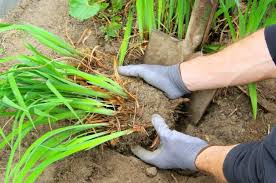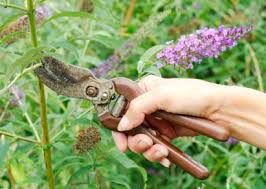Priming Your Garden For Springtime
- Wednesday, 13 April 2016 08:16
- Last Updated: Wednesday, 13 April 2016 08:26
- Published: Wednesday, 13 April 2016 08:16
- Joanne Wallenstein
- Hits: 9148
 Local landscaping professional Manny Grossman is helping many local gardeners get their properties primed for spring. In addition to designing, installing and maintaining properties, Grossman teaches at the New York Botanical Garden. Here's his advice for your perennial garden, shrubs, and more:
Local landscaping professional Manny Grossman is helping many local gardeners get their properties primed for spring. In addition to designing, installing and maintaining properties, Grossman teaches at the New York Botanical Garden. Here's his advice for your perennial garden, shrubs, and more:
What do you recommend that gardeners do to prepare their gardens for the spring? Can you give some tips on dividing perennials? How can you avoid killing them?
Spring, especially March and April, is all about cleanup. This is the time to take away any excess debris from under plants. Cut back any dead perennial or grass tops. It is also the time to make decisions about what worked and what didn't work last year. If you didn't like the placement of a particular shrub or perennial, spring is the time to move them to an area that will work better. Try to get a head start on weeding. Weeds are easiest to pull in their seedling stage. Whether you use your hands or a tool is dependent on the weed and the severity of its infestation.
Another commonly overlooked task is removing any remaining fall leaves out of shrubs. Leaves left in shrubs diminish air and sun into the interior of the plant. This can easily cause holes or dead spots within a shrub. This is the most common mistake I see in gardens all over Westchester.
One garden practice that should be left in the past is excessive cultivation or turning of the soil. Soil is an ecosystem that, like all ecosystems, prefers to be left alone. Mindlessly turning over or cultivating your soil can rip feeder roots and cause unnatural air/oxygen levels in the soil. It also kills earthworms and can destroy your soil structure, which is extremely important to the overall plant health. Remember, the woods don't cultivate themselves, at least in the unnatural way we do it. They also don't go to Home Depot for the bags of petrochemicals we call fertilizers.
Dividing perennials is easy, but you must first do some research on the plant you want to divide. Can it be divided? If so, what is the best technique? Some plants want to be left alone, and some plants love to be split apart. The key is to know what you are doing before you do it. In this, the internet is your friend and should be used to the fullest extent possible. Youtube is full of plant division videos and most of them can be safely relied on.
some research on the plant you want to divide. Can it be divided? If so, what is the best technique? Some plants want to be left alone, and some plants love to be split apart. The key is to know what you are doing before you do it. In this, the internet is your friend and should be used to the fullest extent possible. Youtube is full of plant division videos and most of them can be safely relied on.
Do you recommend mulch? If so what kind?
Absolutely, but you should wait until your soil warms up before you apply it. This means your mulching time should not be before May 15th or so. A lot of time you will see landscaping services mulching first thing in the spring. This wrong. Mulch is an insulation blanket over the soil, and if you mulch cold soil, your plants may not perform as well early in the season. This is because plant growth is regulated by the roots' perception of higher soil temperatures.
There are many kinds of mulch for different purposes in the garden. However, I recommend for most purposes organic shredded cedar mulch. It should be natural color, i.e. not dyed. It can be bought in bags or in truckloads. It is the most ornamental of all your choices and does what we want mulch to do, which is unify the look of the garden while helping to control weeds and conserve moisture.
Any tips on which shrubs to prune now? And which to leave alone?
 Pruning is an art and science which one should do a lot of reading about before actually doing. The general rule of thumb with pruning is to be careful you don't prune off flower buds. Thus, spring flowering shrubs like Rhodies should be pruned after flowering. Fall flowering shrubs can be pruned in the spring. In reality, you can prune anytime of the year, except maybe in the deepest winter (although a lot of pros do it then too). It's just a matter of if you care about flowering or not. If you do, then research the shrub in question and find out when the best time to do it is. I highly recommend a book called The Pruning of Trees, Shrubs and Conifers by Brown and Kirkham. This is the only book on pruning you will ever need. Clean tools and knowing good technique are very important too.
Pruning is an art and science which one should do a lot of reading about before actually doing. The general rule of thumb with pruning is to be careful you don't prune off flower buds. Thus, spring flowering shrubs like Rhodies should be pruned after flowering. Fall flowering shrubs can be pruned in the spring. In reality, you can prune anytime of the year, except maybe in the deepest winter (although a lot of pros do it then too). It's just a matter of if you care about flowering or not. If you do, then research the shrub in question and find out when the best time to do it is. I highly recommend a book called The Pruning of Trees, Shrubs and Conifers by Brown and Kirkham. This is the only book on pruning you will ever need. Clean tools and knowing good technique are very important too.
Many landscapers are recommending the use of native plants. What's your thought on these? Are some invasive?
This is a subject that often gets me into  trouble as my opinion differs from the mainstream. I don't believe in the notion of "native" plants. Plants move. They always have and always will. Plus, the artificial date set by most native gardeners as to what is native or not is 1492, which is when Columbus supposedly discovered the new world. In reality, people from all over the world have been coming to North and South America for thousands of years, and in many cases brought plants with them. For instance, one of the first plants discovered in the western U.S. by the first European settlers was the Cherokee Rose. This plant is native to China. Hmmmm?
trouble as my opinion differs from the mainstream. I don't believe in the notion of "native" plants. Plants move. They always have and always will. Plus, the artificial date set by most native gardeners as to what is native or not is 1492, which is when Columbus supposedly discovered the new world. In reality, people from all over the world have been coming to North and South America for thousands of years, and in many cases brought plants with them. For instance, one of the first plants discovered in the western U.S. by the first European settlers was the Cherokee Rose. This plant is native to China. Hmmmm?
To me, the question should really be is a plant invasive or not? I never plant invasive plants (with a few groundcover exceptions like Vinca or Pachysandra), whether native or non-native. There are many native plants that are complete garden thugs. As great as the native Milkweed is at bringing in butterflies, it is a highly invasive plant that your neighbors might not appreciate colonizing their garden. On my farm in Puerto Rico, mangoes, avocados and coconuts are all "non-native," yet I would hardly classify them as a problem for the local ecosystem.
What's your recommendation for lawn care-- do use lime treatment, crabgrass control or chemicals?
My real recommendation is rip out your lawn and plant useful trees, perennials and food. I do no lawn care in my business because I believe lawns are outdated vestiges of our colonial past. In England, the conditions are perfect for lawns. But in North America, the conditions are abysmal for having a green lawn, unless of course you use huge amounts of water, artificial fertilizers and extremely toxic chemicals. No, I'd rather work with nature than bludgeon it with chemicals, all of which are horrific for our immune systems and reproductive systems, not to mention the effect they have on our wildlife, waterways and air quality.
If you must have a lawn, then I highly recommend finding a lawn care company that makes an effort to be as non-toxic as possible. But remember, disease occurs in plants (and humans) when systems are out of balance. People get all sorts of lawn problems because they are trying to grow plants that simply does not want to exist in this eco-system, at least at the scale in which we plant it.
What are some your favorite perennials that are hearty and easy to care for and grow well in Scarsdale?
Scarsdale, unlike other Westchester communities, is lucky that in that we don't have a real deer problem, so the list of perennials that will thrive here is endless. But at the top of my list would be Catmint, Russian Sage, Anemone, Asters, Roses, any ornamental grass and Sedum.
For shrubs and trees I recommend hydrangea, viburnum, spirea, rhododendron, azalea and as many conifers as you can fit. All these plants are "set and forget" plants and require very little attention.
Tell us something about yourself, what you do, where you teach and tell people where to contact you.
I have been gardening professionally since 2008. I was trained at Wave Hill and incorporated Rogers Gardening Service in 2009. I spent several years taking care of fine gardens in Westchester, but more recently I have focused more on larger apartment complexes. I am the head gardener at Fieldston Gardens in Riverdale and at Castle Village in Washington Heights. I have been teaching classes at the NYBG School of Continuing Education since 2012. I teach horticulture and gardening classes. I am also a certified Permaculture instructor and designer and I own nine acres in Puerto Rico where I am cultivating a perennial food forest for my retirement years. My whole approach to gardening is to step back and let nature work. Of course, this often requires a little more advance planning, but the results will be much better for you and the environment.
Send your questions to Manny Grossman at rgsgarden@gmail.com. He offers garden design, installation, maintenance and restoration.







